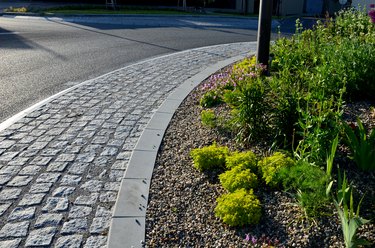
Over time, your new pavers might appear to be collecting and growing stains. While some of this is due to normal wear and tear, other types of buildup occur due to the curing process of concrete. Many homeowners decide to acid wash pavers, as doing so removes stains and restores their appearance. However, doing this the wrong way can cause severe damage to the pavers themselves, so wash them with caution.
White Buildup on Pavers
Video of the Day
Often, homeowners see white buildup on the surface of their concrete pavers. This discoloration is called efflorescence, and it is part of the natural process that occurs as concrete cures over a long period of time. This causes a compound called calcium hydroxide to form and bloom on the surface of the paver.
Video of the Day
A calcium carbonate salt compound forms when the calcium hydroxide mixes with the carbon dioxide in the air. This appears as a white powderlike substance on the exposed surface of concrete pavers. This mixture of salt and basic compounds is harmless, and it can be removed with an acidic treatment. However, if your pavers aren't stained from natural efflorescence, you will need to do some research on how to remove it.
Handling Muriatic Acid for Pavers
Muriatic acid is one type of diluted hydrochloric acid. Hydrochloric acid is an incredibly strong acid, and it can be dangerous to work with this substance. Hydrochloric acid can cause irritation to the skin, eyes and lungs, and at higher concentrations, it will cause corrosive burns. Muriatic acid is diluted with water to a concentration between 14.5 and 29 percent. While this is still dangerous, these dilutions are much easier to handle.
Use extreme caution when using muriatic acid to wash pavers. Remove or cover any metal objects since the acid can damage metal. While muriatic acid is fairly natural, you can minimize any potential damage to your lawn by soaking it with water first. This will dilute any runoff.
Wear protective eye gear, hydrochloric-acid-resistant gloves and tough clothing to protect your skin, such as long pants, long sleeves and boots. Generally, you should use this product outside. However, if you're considering an indoor wash, use extreme caution and ensure that the space in which you're using it has plenty of ventilation.
Additional Muriatic Acid Tips
Keep in mind that muriatic acid must be further diluted. This acid wash can do severe damage to your concrete pavers. If the concentration is too high, the acid will start to eat away at the surface of the pavers. Closely follow the directions on the container to dilute the muriatic acid. Most products recommend a 12:1 ratio of water to acid. Always fill the watering can with water first and then add the acid.
After you clear a space, pour the mixture from a watering can over a small, manageable area. After about three minutes, generously hose off the muriatic acid solution before it can start to damage your pavers. Working with small pieces will help you avoid any damage, and your pavers will emerge clear of efflorescence.